Pakistan 2000: Karakorams, J.S. Milne
Last revised July 9, 2000. Sometime (maybe) I'll add more captions.
When someone is so naive as to ask me why I keep going to Nepal, I always respond (paraphrasing Willie Sutton) "Cos that's where the mountains are." But that's not where all the mountains are: of the fourteen peaks over 8000m, only eight are in Nepal and one more is visible from Nepal; the remainder, K2, Broad Peak, Gasherbrum I, Gasherbrum II, and Nanga Parbat are in Pakistan. Thus, it was time for me to head to the Karakorams to seek my first view of these peaks. The best trek for this goes from the town of Skardu up the Baltoro glacier and then over the wonderful Gondogoro La [Pass]. Pakistani regulations require that you hire a guide and hence a cook etc., and there are no villages or even tea houses on the way, and so this would not be a lightweight trek.
On June 7, my guide Sarwar and I flew from Islamabad to Skardu in a Boeing 737. For a short time during the flight I was able view the mountains, including Nanga Parbat, from the cockpit. The next day, while Sarwar hired the porters and arranged the food and equipment, I went for a walk and saw this massive rock carving illustrating that the valley had not always been Muslim.

Day 1. Went by jeep from Skardu 2200m to Askole 3000m

Houses at Askole

Children at Askole
The British mountaineer Doug Scott arranged for Askole to have clean water, provided by a pipe from a clean stream above the village. Sarwar saw a woman nevertheless getting drinking water from the stream (sewer) flowing through the village. "Why?" he asked. "Because it tastes better" she said.
Day 2. Walked to Jhola

A fragile looking bridge

Sarwar crossing the Dumordo river
Day 3. Walked to Paiju
This, like the previous two days, was overcaste with some light rain.
Day 4. Rest day at Paiju
It is an unbreakable tradition that the Balti porters buy a goat at Askole, and spend a day at Paiju resting and partying.

The view from Paiju looking up toward the Baltoro glacier --- this was the first really fine day of the trip

Balti porter

Balti porters cooking.
Sarwar had told me so many stories of parties walking to Concordia and back without getting a view of K2, and walking to Concordia and not being able cross the Gondogoro La because of bad weather, that I decided we would make good use of the fine spell. Thus, we walked to Concordia in 3 days from Paiju instead of 4, and spent only one day at Concordia instead of 2. The two days we saved turned out to be crucial to the success of the trip.
Day 5. Walked to Urdukas


Day 6. Walked to Goro II

Day 7. Walked to Concordia 4650m
Day 8. Walked to K2 base camp 5000m and back

Broad Peak

K2

K2 Base Camp
Day 9. To Ali Camp 5010m
Day 10. Crossed Gondogoro La 5640m to Xhuspang
We planned to leave Ali camp at 2am for the pass, but by 1am the porters were already waiting silently around our camp for their loads (they knew that there could be dangerous rock fall on the other side of the pass once the sun was on it), and so we left at 1:30am. Sarwar, the cook, and I went ahead crossing the glacier to the foot of the pass. When the slope began to steepen, we put our crampons on. [The guide book speaks of 50 degree slopes, but they weren't that steep. We did have to wind our way through some monster crevasses.] While Sarwar took care of the porters by fixing the 60m rope we had brought with us, I climbed alone up to the pass. It was a dazzling experience to arrive on the pass just as the sun was beginning to rise over Gasherbrum I to the east of us. The four 8000m peaks K2, Broad peak, Gasherbrum I, and Gasherbrum II were clearly visible. Sarwar arrived with the porters about 30 minutes later. Photography was tricky in the lighting, but here are some of the views from the pass.

K2 and Broad Peak behind


The porters arriving on the pass with Broad Peak and Gasherbrums IV and II behind.

Sarwar and the porters resting on the pass.
The porters showed surprising emotion on reaching the pass, giving each the other the Pakistani equivalent of the high-five(a clasp of the right hand and a half-hug). The cook even danced for joy (literally!) on reaching the pass --- he had been to Ali camp four times but had been prevented each time by bad weather from crossing. One of the two young porters, for whom this was the first crossing, later built a rock tower six feet high to celebrate the event.

A straggler being escorted up

K2
Day 11. Climbed Gondogoro Pk c5700m
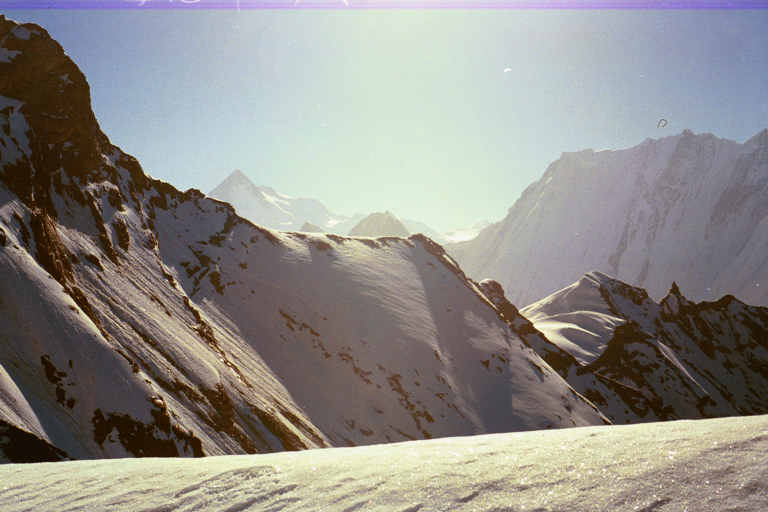
View from Gondogoro Peak toward Gondogoro La (it is the flat snow area at lower right); Gasherbrum I is visible behind (at left)

Sarwar on top of Gondogoro Pk (the slopes behind are on the other side of a glacier)
Moments later he fell on the first steep step in the next picture, but we had put the rope on for the descent, and I had him on an iceaxe-boot belay.
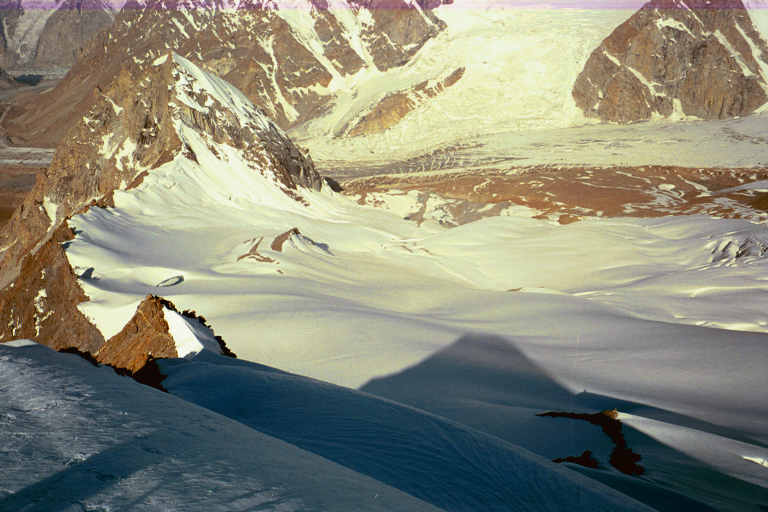
View down our ascent route --- the last 150m were a series of increasingly steep and icy steps.

View back at Gondogoro Peak
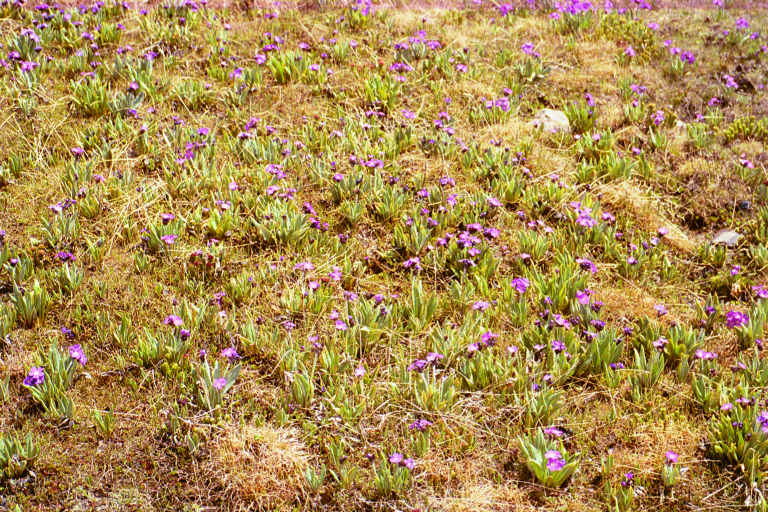
After the rocks and moraine of the Baltoro, the grass and flowers of the Hushe valley were a delight
Day 12. To Daltsampa 4250m
The next morning it rained, and we ambled down the valley to the next camp site.
[The weather was fine enough early for two parties to cross the Gondogoro La, but they had no views. For the next 2 days the weather was so bad that no one was able to cross the pass.]

Rain at Daltsampa. With only a tarp to protect them from the elements, the porters should have been miserable, but they insisted on being happy --- singing and joking to pass the time
Day 13. To Shaishcho
It rained again, and we again had a short walk to the next camp site.
Day 14. To above Spangser c4300m
The weather appeared to be improving, and we set off for the K7 base camp.

Day 15. To K7 base camp c4530m

K6 from the K7 base camp.
Day 16. Climbed small peak c5200m above K7 BC

View looking down at the K7 camp from the small peak
For the six remaining porters, this had been an unusually long trip, and they were anxious to get home. When told that we would be going down next day, they broke into cheers, and, yes, one even danced for joy.
Day 17. Descended to Hushe (a village at the end of the jeep road).
In the morning, I told the porters that they should be weeping to be leaving such a beautiful place, but this did nothing to dampen their joy. They walked fast and by lunch we had descended what had taken us two days to ascend. By mid-afternoon we were in Hushe.
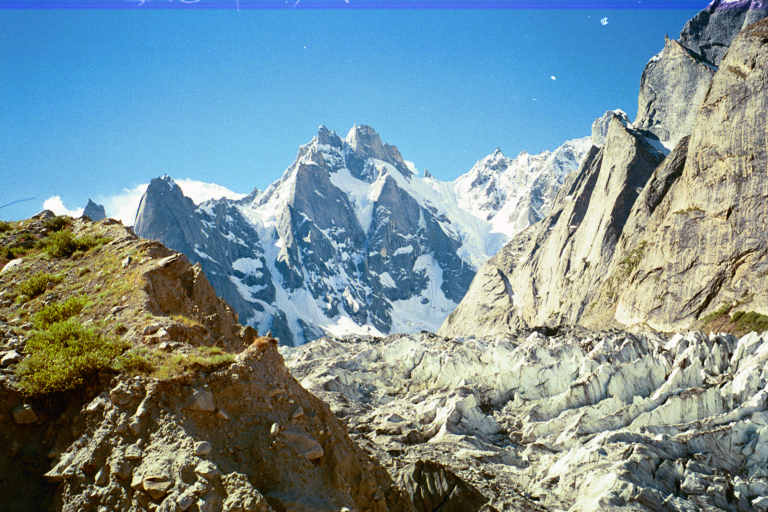
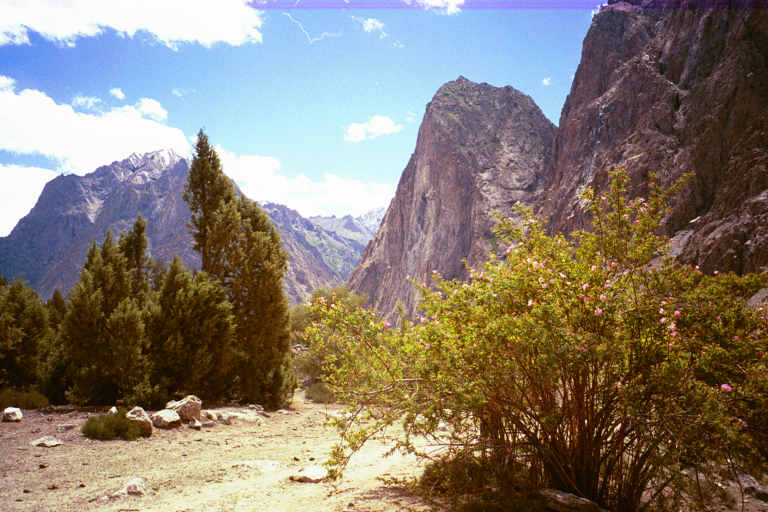
View down the valley on the way from Shaishcho to Hushe.

The baba (old man) of the porters. He said he was 56, and had a 6 month old daughter by his 18 year old wife (his third). This day, he was the fastest of the porters.
Day 18. Walked to Honbrook 3970m and back
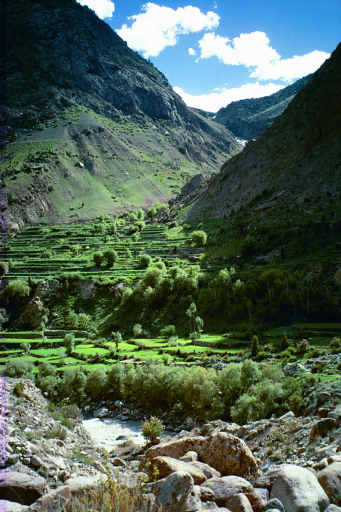
The richly irrigated fields of Honbrook
Day 19. Walked to Masherbrum base camp 4280m and back
The guide book describes the walk from Hushe to the Masherbrum base camp and back as a five-day trek, but I decided it would make a good last day (after all, I didn't have to walk again for the next four weeks). Sarwar came with me, and we hired a local Hushe man as a guide, who was happy for the exercise since he was leaving next day to serve as a high altitude porter on Nanga Parbat with Messner.
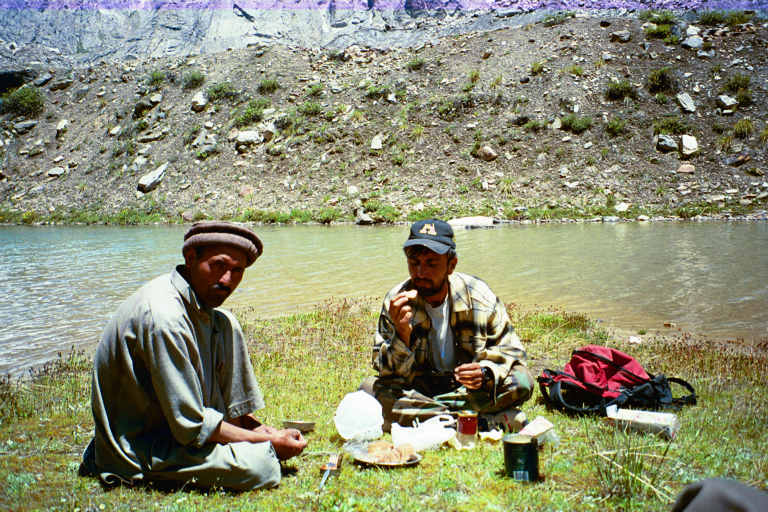
The Hushe man and Sarwar having lunch at the Masherbrum base camp

When we returned, our cook (right) and Shukru (helper and porter) were all spruced up, so I took their photo.
Day 20. By jeep to Skardu

On the afternoon of our return to Skardu, the usual windstorm was especially strong and menacing, but our luck held, and we were able to fly back to Islamabad the following morning.
Copyright 2000, J.S. Milne.



































